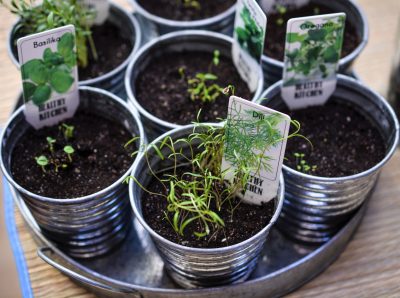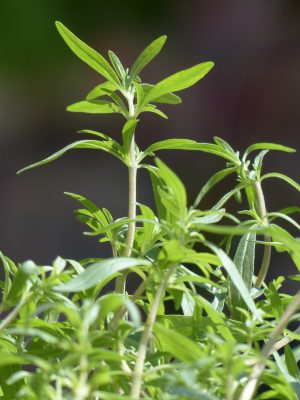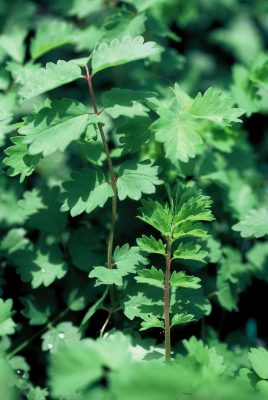Using herbs is the simplest, freshest and easiest way to add flavour to food. Growing your own means even more fresh flavours at your fingertips.
Chefs, and home cooks have been using herbs for centuries. It is the earliest form of culinary flavouring that probably started when a nameless cook rubbed some aromatic leaves over the flesh of the day’s hunt as it roasted on the fire and thought, ‘this smells good!’.
That’s the appeal of herbs, they add fragrance as well as flavour, and having fresh herbs at one’s fingertips is a cook’s best strategy. Fresh herbs will always be superior to dried herbs and other flavourings.
Why grow from seed?
It offers far more variety than you’ll find on a garden centre’s herb stand or seedling rack. It also means that you can grow only what you need and save the rest of the seed for later crops.
Seed stored correctly can last for up to three years, and it’s a much more affordable way to garden.
Just make sure the seed packet is sealed, put it in a shoebox and store it in a cool dry place. A desk drawer also works. Just don’t forget about the packets or where you’ve stored them.
 Sowing tips
Sowing tips
Herb seed can be sown directly into the soil, in seed trays or in single pots. It depends on what you need or prefer and the available space.
Using seed trays or individual pots is a manageable way to start your herbs, especially if you want to keep growing the herbs in pots or only want one or two herbs of each variety. It is also a good option if you want to interplant the herbs among vegetables or in the flower garden
However, you may prefer to sow directly into the soil in a sunny bed. Direct sowing suits herbs like rocket, sorrel, coriander, chives and chervil that can be grown as cut and come again herbs. Then they can be sown more thickly and thinned out or cut back.
Getting started in seed trays
- Use a germination mix and make sure it is damp before sowing. Check the seed packet for recommended sowing depth. Place the seed trays in an area with good light, but not direct sunlight.
- After sowing dampen the soil with a fine spray, using a spritzer bottle and cover the seed tray with clear plastic, to keep in the moisture. Remove the plastic once the seedlings start to grow.
- Keep the soil moist and once the seedlings emerge feed with organic Margaret Roberts Supercharger and repeat two weeks later
- Transplant into pots or the garden when the seedlings have developed the second set of true leaves. Water regularly, but don’t over water.
Culinary herbs for summer
Culinary herbs that grow easily from seed are basil, chives, coriander, dill, rocket, and sorrel, as well as four new herbs that Kirchhoffs have introduced to their summer range.
What’s new?
 Mexican Mint Marigold (Tagetes lucida) is an aromatic perennial herb that looks like a marigold but has intense tarragon-flavoured leaves and a strong liquorice/anise fragrance. It is a great substitute for French tarragon because it tolerates heat and drought, unlike French tarragon. The flavour is a little stronger and sweeter than French tarragon.
Mexican Mint Marigold (Tagetes lucida) is an aromatic perennial herb that looks like a marigold but has intense tarragon-flavoured leaves and a strong liquorice/anise fragrance. It is a great substitute for French tarragon because it tolerates heat and drought, unlike French tarragon. The flavour is a little stronger and sweeter than French tarragon.
To grow: this heat and drought tolerant herb thrives in full sun in ordinary garden soil that drains well or in pots. The plant forms a clump that can be divided after two to three years.
Uses: Harvest the individual leaves or sprigs, chop and add the fresh leaves to sauces, salads, soups and chicken dishes or make a stimulating and refreshing tea from the leaves.
http://www.kirchhoffs.co.za/product-category/herbs/marigold-mexican-mint/
Summer Savory (Satureja hortensis) is a low growing summer annual (30 to 40cm) with narrow, bright green leaves. The fresh leaves have a sweet yet peppery flavour that contain hints of thyme, marjoram and mint.
 To grow: Like basil, summer savory grows easily from seed. Start it in seed trays in early September for planting out towards the end of the month or direct sow after the last frost. Plant in a sunny bed and water regularly. Once established summer savory can tolerate hot, dry conditions.
To grow: Like basil, summer savory grows easily from seed. Start it in seed trays in early September for planting out towards the end of the month or direct sow after the last frost. Plant in a sunny bed and water regularly. Once established summer savory can tolerate hot, dry conditions.
Uses: Start picking the leaves when plants are about 15cm tall. The best time to harvest the leaves is in the afternoon when the essential oils are strongest. Use to flavour Mediterranean dishes, rich sauces and slow cooked bean and meat dishes. Young sprouts add a burst of flavour to salads, sandwiches and as a topping for pizza.
http://www.kirchhoffs.co.za/product-category/herbs/savoury-summer/
Chervil (Anthriscus cerefolium) is a delicately flavoured herb that grows best in cooler weather, spring or autumn. It produces fine soft leaves and grows between 30cm to 60cm high.
 To grow: Plant in an area that receives lightshade and water regularly to keep the soil moist, but not sodden. Sow direct into the soil as it has a long tap root and doesn’t transplant easily.
To grow: Plant in an area that receives lightshade and water regularly to keep the soil moist, but not sodden. Sow direct into the soil as it has a long tap root and doesn’t transplant easily.
Uses: Its delicate taste with an overlay of aniseed adds fragrance to creamy soups, sauces, omelettes and other egg dishes, grilled fish (as part of a herb butter) and salads. It is best added at the end of cooking as a flavouring garnish, otherwise the delicate taste will be lost. An infusion of the leaves stimulates digestion, relieves head colds, and acts as a blood cleanser.
http://www.kirchhoffs.co.za/product-category/herbs/chervil/
Salad Burnett (Sanguisorba minor) is a lesser-known perennial herb that is well worth discovering. The fresh young leaves have a cucumber-like flavour.
 To grow: This low growing, bushy herb has small red flowers and is a good border plant in the flower or herb garden. It grows in sun or semi-shade and during very hot months it should be watered regularly. In very cold areas it may die back in winter but will shoot again in spring. To keep the plant looking good remove dead leaves and spent flowers.
To grow: This low growing, bushy herb has small red flowers and is a good border plant in the flower or herb garden. It grows in sun or semi-shade and during very hot months it should be watered regularly. In very cold areas it may die back in winter but will shoot again in spring. To keep the plant looking good remove dead leaves and spent flowers.
Uses: the cucumber-flavoured leaves can be used in salads and salad dressings, chopped up and added to cream cheese or soft cheese, used in herb butters, and added to casseroles and soup. The leaves contain vitamin C and if made into a tea can be drunk as a tonic.
Good to know: Water newly planted herbs regularly until they are established and then water less often; once a week in summer and once a month in winter. Feed monthly or every two weeks with an organic liquid feed at half strength.
http://www.kirchhoffs.co.za/product-category/herbs/salad-burnett/
Text: Alice Coetzee


